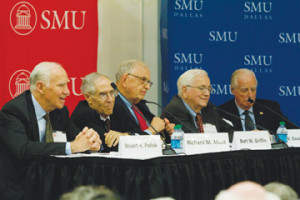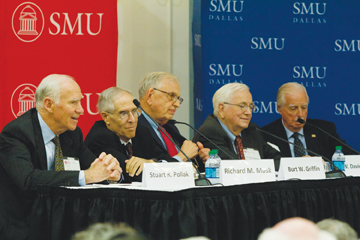
Six members of the Warren Commission participated in a two-part panel in Umphrey Lee’s Mack Ballroom Friday. The event was organized by the SMU Tower Center for Political Studies along with the SMU Dedman School of Law and the Sixth Floor Museum. The members discussed their roles on the Commission and its ultimate findings.
To an audience of about 300, the Commission members reasserted their original conclusion: that one man, Lee Harvey Oswald, carried out the assassination of President John Kennedy and that there was no conspiracy.
Formally titled “The President’s Commission on the Assassination of President Kennedy,” the Warren Commission took its unofficial name from its chairman, Chief Justice Earl Warren. President Lyndon Johnson created the Commission in 1963.
The first part of the event featured five Warren Commission members. These included three men who had served as assistant counsel, Judge Burt Griffin, Professor David Slawson and Howard Willens; and two former staff members of the Commission, Justice Richard Mosk and Justice Stuart Pollak. This group discussed the processes of the Commission and how its conclusions came about.
“We presided over the most extensive criminal investigation ever conducted in the United States,” Willens said. A total of 552 witnesses provided testimony. This included the sworn testimony of 94 witnesses, 395 depositions, 61 affidavits and two written statements. On the basis of all this, Willens said, “the Commission would shape its conclusions.”
In addition to the testimonies, the Commission also examined the plausibility of a conspiracy. Slawson worked on this part of the investigation. Among other points, Slawson researched Lee Harvey Oswald’s possible connection to Russia.
After Oswald’s death, the Commission found a private diary that Oswald had kept of his adult life. In the diary, Slawson said, Oswald “recorded that he had made up his mind while he was in the Marine corps” to defect to Russia. Oswald did spend some time in Russia, but eventually came back to the United States.
“We studied all of this as best we could to see if there was anything sinister about it,” Slawson said, “and the final decision was negative.” There was no conspiracy.
The Commission’s findings were given to Johnson on Sept. 24, 1964. They concluded that, “there was one shooter, he [Oswald] acted alone [and] he acted without the involvement of any other person,” Pollak said.
The second part of the event introduced Jay Vogelson, another former member of the Warren Commission staff, and four SMU professors. This group had the chance to pose their own questions to the Commission members about the Commission’s methods and conclusions.
SMU English Professor Tom Stone voiced his concerns with certain procedures the Commission took during the investigation. It was his understanding that no one on the Commission inspected the autopsy X-rays and photos, Stone said.
Willens addressed Stone. “The autopsy X-rays and photographs were seen by [Warren],” Willens said. However, he also added, “In retrospect, it was a mistake not to enable those materials to be used by at least one of the autopsy doctors” during their testimony. This would have given the doctor an opportunity to give a more grounded statement.
The Commission’s investigation was not perfect, but “the thoroughness, the intensity and the desire of everybody involved…to serve the truth and to lay out the whole story was unquestionable,” Pollak said.
Willens believes that the Commission’s findings have “withstood the test of time.” This sentiment was echoed by several of the panelists.
“Nothing, in my judgment, has come to light in the almost 50 years since the report that casts any credible doubt on the ultimate conclusions to which the Commission came,” Pollak said.
The main voice of the Commission is in its report, an 889-page volume that lays out the extensive investigation, but seeing the Commission members speak presents a different aspect apart from their conclusions.
“[The panel] has been very eye-opening,” SMU senior Brandon Bub said. “The… experience of listening to the people involved, [and] getting an idea of what they did is a humanizing way to look at [the Warren Commission].”









